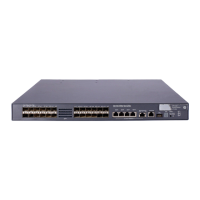12
Figure 4 Speed auto negotiation application scenario
All interfaces on the switch are operating in speed auto negotiation mode, with the highest speed of
1000 Mbps. If the transmission rate of each server in the server cluster is 1000 Mbps, their total
transmission rate will exceed the capability of interface GigabitEthernet 1/0/4, the interface providing
access to the Internet for the servers.
To avoid congestion on GigabitEthernet 1/0/4, set 100 Mbps as the only speed option available for
negotiation on interface GigabitEthernet 1/0/1, GigabitEthernet 1/0/2, and GigabitEthernet 1/0/3. As
a result, the transmission rate on each interface connected to a server is limited to 100 Mbps.
To configure an auto-negotiation transmission rate:
To do… Use the command… Remarks
1. Enter system view
system-view —
2. Enter Ethernet interface view
interface interface-type interface-
number
—
3. Set speed options for auto
negotiation
speed auto { 10 | 100 | 1000 } * Optional
This function is only available for Gigabit Layer-2 copper (electrical) Ethernet interfaces that support speed
auto negotiation.
The speed and speed auto commands supersede each other, and whichever is configured last takes effect.
Configuring traffic storm protection
A traffic storm occurs when a large amount of broadcast, multicast, or unknown unicast packets congest a
network. The HP 5800 and the HP 5820X switches provide the following storm protection approaches:
• Storm suppression, which enables you to limit the size of monitored traffic passing through an
Ethernet interface by setting a traffic threshold. When the traffic threshold is exceeded, the interface
discards all exceeding traffic.
• Storm control, which enables you to shut down Ethernet interfaces or block traffic when monitored
traffic exceeds the traffic threshold. It also enables an interface to send trap or log messages when
monitored traffic reaches a certain traffic threshold, depending on your configuration.
For a particular type of traffic, configure either storm suppression or storm control, but not both. If both of
them are configured, you may fail to achieve the expected storm control effect.

